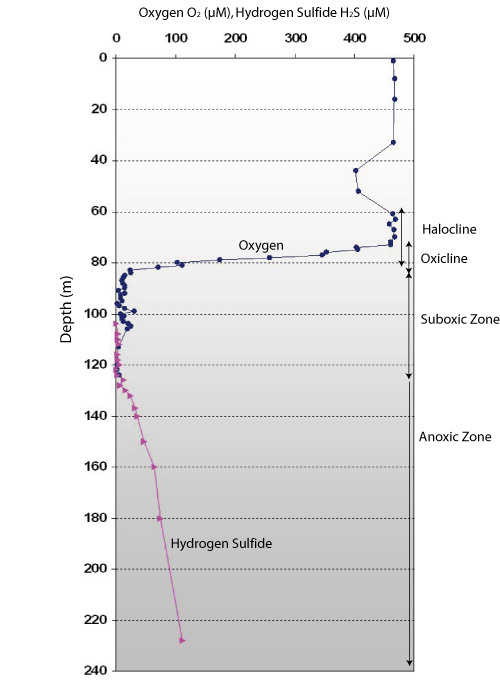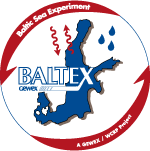| Background > Water column profiles
Oxygen is depleted in the deep water and hydrogen sulfide is produced
The profile below shows the vertical distribution of oxygen (blue symbols) and hydrogen sulfide (pink symbols). The water above the halocline is well oxygenated. Heterotrophic organisms (bacteria, protists, animals) use oxygen for their metabiolism, and remove it from the water (respiration). Diffusion from the air above the sea surface and the activity of autotropic organisms (phytoplankton, plants) results in an enrichment of the water in oxygen (photsynthesis). Due to this activity, the surface water is often oversaturated with oxygen, and it gases out to the atmosphere.
The most prominent feature in this graph is the rapid decline of oxygen at a depth of about 75 to 82 m. The oxygen drops from 480 µM to less than 10 µM just a few meters down. This layer is called the oxicline (or chemocline; redoxcline). Note that it is situated in the halocline. Here, very small organisms accumulate and by their activity change the chemistry of the sea water (this will be further explained in the following nitrogen profiles). Below the oxicline, a deep layer of suboxic conditions prevails, until about 130 m. This layer is a transition zone between oxic and anoxic conditions and accomodate a number of interesting biogeochemical transformations, in which many different microorganisms are involved (the nitrogen related transformations will be discussed in the following graphs). In this transition zone, the ubiquitous sulfate is being used more and more for respiration by a certain type of bacteria. The "waste product" of this process is the hydrogen sulfide, which accumulates in depths where oxygen is almost (suboxic) or completely (anoxic) depleted. Hydrogen sulfate smells like rotten eggs and can be perceived also when anoxic mud is stirred up.

Go on to the nitrate and ammonium profiles...
|

